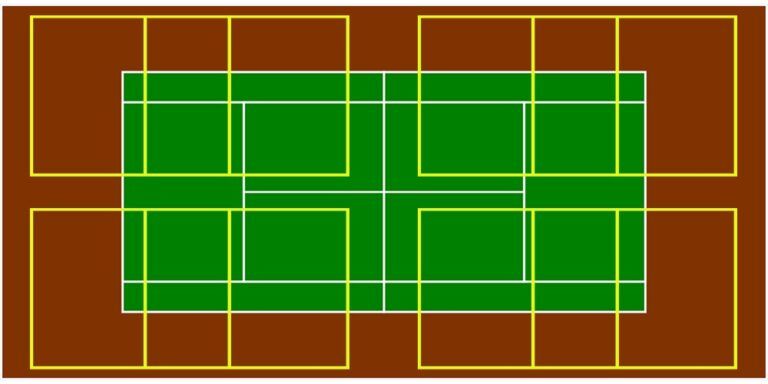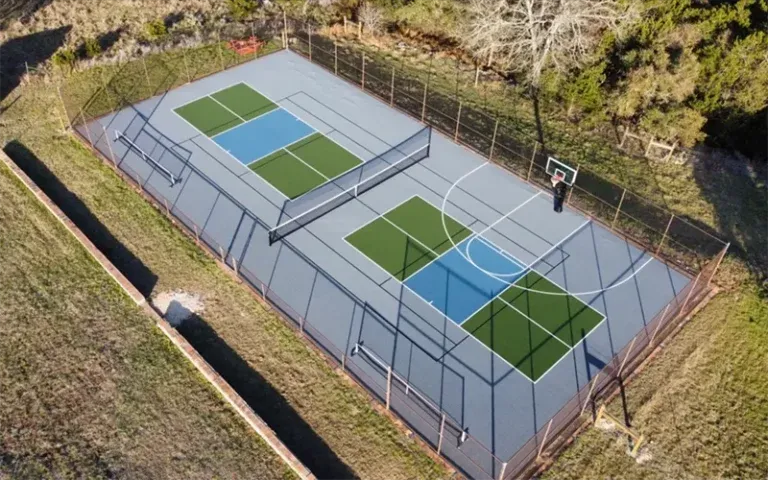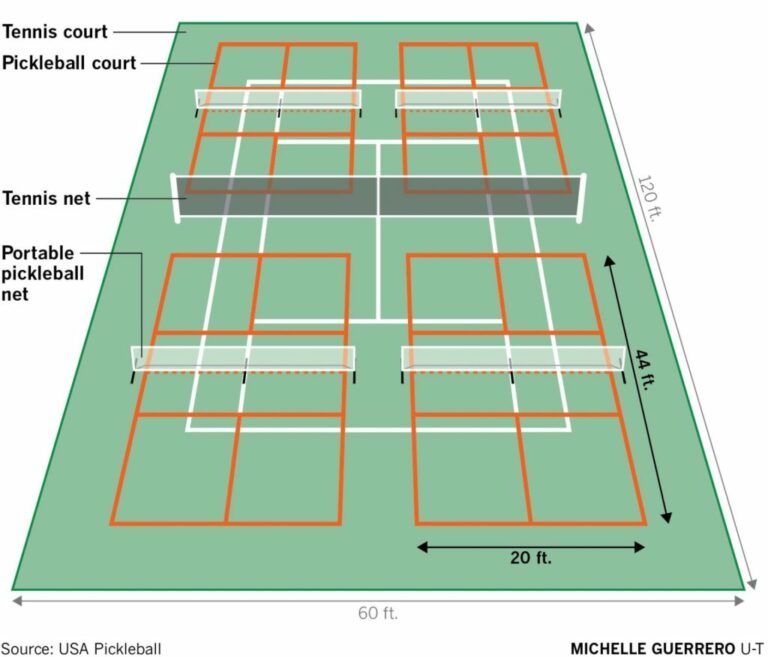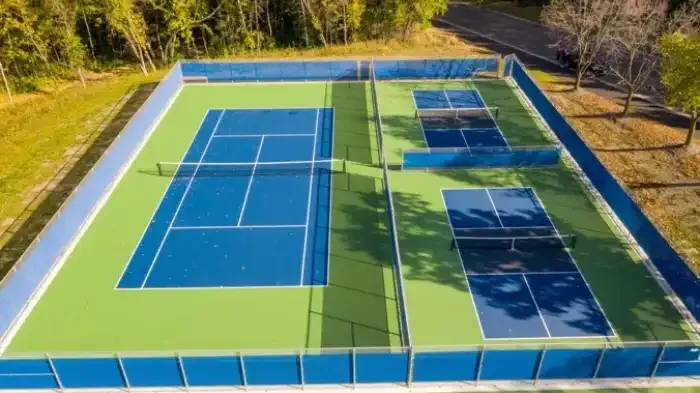How many pickleball courts fit on a tennis court
Typically, up to four pickleball courts can comfortably fit on a standard tennis court. A standard tennis court measures 60 feet in width and 120 feet in length, while each pickleball court requires a space of 20 feet by 44 feet. This geometric compatibility allows for a practical arrangement where two courts can be positioned on either side of the tennis net, thus optimizing the existing space.

To visualize this layout, consider the arrangement: with the tennis net serving as a dividing line, two pickleball courts can occupy each side, fully utilizing the tennis court's width. The extra area provides ample room for players to maneuver while minimizing interference. This means that although it is feasible to set up four pickleball courts, practical considerations often lead to the use of two or three courts for enhanced gameplay comfort and safety.
The popularity of pickleball is not just a fleeting trend; it is a reflection of a larger movement towards inclusive and engaging community sports. Facilities that convert tennis courts into multiple pickleball courts can significantly aid in accommodating the growing number of players eager to join the fun. Given the affordable and adaptable nature of this conversion, many community centers and recreational areas are exploring these opportunities.
Understanding the pickleball boom and the need for more courts
Pickleball's popularity and the demand for courts
In recent years, pickleball has captured the hearts and minds of players around the globe, transforming from a curious backyard pastime into a competitive sport played in organized leagues. According to the Sports & Fitness Industry Association, pickleball participation in the United States grew by over 85.7% in 2022 compared to the previous year. This staggering growth leads to a court shortage, as many facilities find themselves unable to keep up with demand.
The demographic appeal of pickleball spans generations, thanks to its adaptability and engaging nature. Unlike more intense sports that may require higher fitness levels, pickleball provides a welcoming environment for players of all ages. This blend of accessibility and competitive spirit generates an impetus for community centers to explore converting existing tennis courts into dedicated pickleball spaces, addressing the pressing need for more playable areas.
Why convert tennis courts to pickleball courts?
Considering the demand, converting tennis courts into pickleball courts presents a cost-effective solution that benefits communities looking to accommodate more players without the expense of building new facilities. Beyond fiscal savings, this approach represents a smart utilization of existing infrastructure. Instead of letting tennis courts remain idle when demand for pickleball surges, communities can optimize their spaces.

In many regions, these conversions can lead to multi-sport usage, attracting diverse groups of players while fostering a spirit of camaraderie. Converting tennis courts into pickleball courts can drive participation across various demographics, strengthening community ties. With pickleball being a game that nurtures social interaction, each newly established court can serve as a hub for engagement and activity.
Court dimensions: tennis vs. pickleball
Tennis court dimensions: the foundation for conversion
It is essential to start with the basic understanding of tennis court dimensions. A standard tennis court (for doubles play) measures 36 feet in width and 78 feet in length. In contrast, a pickleball court measures 20 feet in width and 44 feet in length. This fundamental difference in size is what allows for the flexible arrangement of multiple pickleball courts within a single tennis court area.

These dimensions are critical in guiding how courts can be laid out. When calculating the number of pickleball courts that can fit, one must account for proper spacing, boundaries, and accessibility for players moving between games. The intrinsic value of experiencing both sports in a shared space highlights the versatility of athletic facilities.
Pickleball court dimensions: compact and efficient
The compact nature of pickleball courts makes them especially suited for conversion. Each court’s dimensions allow for players to engage in fast-paced gameplay without compromising the playing experience. The pickleball court is also designed with specific areas, including a non-volley zone, often referred to as the "kitchen," which aids in crafting a unique and strategic component to the game. This zone, located 7 feet from the net, prevents players from executing smashes directly next to the net, adding an element of strategy that enriches gameplay.
Additionally, the strategy behind the sizes reinforces the appeal of pickleball among those looking for a mix of competition and fun. For recreational centers, this compact layout yields an attractive possibility of utilizing a space that might otherwise be reserved for a single sport.
Safety zones and perimeter space
Safety is paramount when designing courts for any sport. With pickleball courts occupying space on a tennis court, it is essential to consider player safety and the spacing between courts. Adequate perimeter space ensures players have enough room to move without risking collisions or distractions from other games. This aspect of layout design is fundamental to creating an enjoyable experience for everyone involved.
Communities must also ensure that clear boundaries are marked for each pickleball court. A lack of defined edges can lead to confusion during gameplay and potentially increase the risk of injury. Thus, strategic planning and proper marking become crucial elements in converting tennis courts to accommodate multiple pickleball courts.
Conversion options: from one to four pickleball courts
One pickleball court: sharing the space with tennis
The beauty of utilizing a tennis court for pickleball lies in its versatility. In some cases, the conversion may only require the addition of a single pickleball court on either side of the tennis net, with remaining space used for tennis. This arrangement allows players to enjoy both sports in the same area, which is particularly beneficial in environments where demand does not justify a complete overhaul of the facility.
When sharing space, marking the lines can be blending to ensure both sports can function seamlessly. Temporary solutions like painter’s tape or chalk can define court edges without committing to permanent changes. This flexible approach appeals to facilities that wish to maintain a diverse offering for their patrons, ensuring that both tennis and pickleball enthusiasts can engage in their favorite activities.
Two pickleball courts: side-by-side action
In situations where demand increases, converting to two side-by-side pickleball courts can be an excellent compromise. This setup allows for more enthusiastic play while still using the tennis court efficiently. By positioning the courts parallel and perpendicular to the net, players can enjoy a lively environment that maintains safety and space integrity.

This arrangement not only maximizes capacity but also fosters an atmosphere of competition and socialization, essential components of the pickleball experience. Tournaments can be organized by utilizing these dual courts, bringing together players from various backgrounds. Community engagement through organized play reinforces the sport’s mission of inclusivity and competition.
Four pickleball courts: the ultimate pickleball hub
Maximizing the capacity of a tennis court for pickleball can reach its pinnacle with the conversion of four courts, creating a true hub for the sport. This setup transforms a community facility into a vibrant pickleball arena that can host leagues, tournaments, and social play. The thrill of having multiple courts supports the growing interest in competitive play, attracting players who are eager to refine their skills.
With four courts in action, communities can gain recognition as essential pickleball destinations. Such facilities can become central to local sports culture, inviting new players and seasoned enthusiasts alike to participate. The shared experience of competing and engaging with others fosters a sense of community and passion for the sport.
Converting a tennis court: a step-by-step guide
Planning your conversion
While the idea of converting a tennis court into multiple pickleball courts is enticing, proper planning is crucial to success. Begin with an assessment of the existing site, taking note of dimensions, space for safety zones, and the condition of the surface. This evaluation will inform the layout design, ensuring it meets official pickleball standards while accommodating additional features like seating or refreshments.
Budgeting for such a conversion will also play a significant role in determining the scope of the project. Factors include materials, labor, and whether any permits are required for modification. Engaging local officials can help clarify potential regulations and guide the project through its implementation stage.
Marking the courts
Once planning is set, the marking of the courts is a key component to a successful conversion. Clear lines for service areas, kitchen zones, and boundary edges must be defined accurately to meet official competition standards. Depending on the facility’s approach, they might opt for more permanent solutions like paint or temporary options such as tape to outline various court elements.
Ensuring the use of high-quality materials during this step guarantees longevity and reduces issues associated with weather impacts. Accurate measurements will be vital to providing an authentic and enjoyable experience, thereby supporting the overall pickleball culture.
Setting up the nets
A key element in establishing usable pickleball courts is the net setup. Unlike tennis nets, pickleball nets have specific height requirements, typically set at 34 inches at the center. Determining whether to adjust existing tennis nets or install portable nets will depend on the facility’s operational needs and future plans for court usage.
Ensuring the nets are secure and meet regulatory standards for both pickleball and tennis enhances safety during play. A well-maintained setup allows for seamless transitions between sports while retaining the integrity of both games.
Resurfacing considerations: creating the ideal pickleball surface
Why resurface?
One often-overlooked aspect of converting tennis courts for pickleball is the need for resurfacing. The surface material plays a vital role in the feel and performance of the game. A proper surface ensures even ball bounce, providing consistency that players must have for optimal gameplay. Inadequate surfaces can lead to injuries and diminish the overall experience, making this step particularly important for those facilitating full-time pickleball courts.
Popular pickleball surface materials
When resurfacing, it is essential to choose the right materials that offer both durability and enhance player comfort. Typical options might include:
- Acrylic coatings: Known for their ability to provide a smooth finish and suitable traction.
- Asphalt: Economical and durable but may require additional coatings for player comfort.
- Concrete: Offers longevity but can be hard on the joints of players.
- Cushioned surfaces: Prioritize player comfort and safety, reducing stress during play.
Reviewing the material options will ensure that converted courts can remain functional and appealing over time.
Finding and selecting a qualified contractor
Finding a skilled contractor experienced in court conversion is vital for ensuring quality and adherence to safety standards. Consider gathering references and quotes from various contractors to gauge their expertise and the expected cost estimates. You'll want to make sure that they are familiar with both tennis and pickleball specifications, confirming that they can deliver a surface that meets the needs of both sports.
Incorporating reliable practices from contractors who provide warranties for their work can save facilities from future repair costs. Choosing a reputable contractor plays a key role in obtaining a successful transition for tennis courts into thriving pickleball attractions.
Enhancing the player experience
Court surface feel and gameplay
Player comfort significantly impacts their overall experience. Factors such as ball response, surface grip, and joint protection should drive choices in court materials. Pickleball players enjoy rallying and engaging in quick games, which makes the surface feel even more critical in maximizing their enjoyment and minimizing fatigue.
Since the popularity of pickleball relies on attracting various players, providing an inviting and enjoyable atmosphere enhances the likelihood of return visits. Each detail, from surface quality to compliant dimensions, contributes to a holistic experience.
Lighting for optimal visibility
Another essential aspect of player experience is lighting. Many facilities benefit from effective lighting solutions, especially for night play. High-quality LED lighting enhances visibility while minimizing glare, allowing players to focus entirely on their gameplay. Properly illuminated courts extend playtime and provide safety for players navigating the court.
Community centers and recreational facilities seeking to accommodate increased play will find investing in effective lighting solutions pays off in terms of satisfaction and usage rates.
Layout strategies for different play styles
Finally, developing thoughtful layout strategies can facilitate the best use of space for various play preferences. For instance, dedicating certain times to social play or competitive matches may ensure players have access to courts suited to their skills and styles. The overarching goal is to be as versatile and accommodating as possible while maintaining a welcoming environment for all.
Accessibility and inclusivity
Creating pickleball courts for everyone
In discussions about converting tennis courts to accommodate pickleball, it is essential to contemplate the aspect of accessibility. Creating courts designed for everyone especially players with disabilities demonstrates a commitment to inclusivity in community sports. Prioritizing features such as wider access pathways and accessible seating helps ensure that all players can engage in the sport comfortably.
Court adaptations for accessibility
Implementing specific adaptations can greatly enhance the accessibility of pickleball courts. This includes:
- Wider spacing between courts, allowing for better navigation.
- Accessible nets that can accommodate players of varying heights and abilities.
- Surface considerations, ensuring a smooth gradient for individuals with mobility aids.
Fostering an environment tailored for diverse needs can ultimately increase participation in pickleball, amplifying the sport's appeal and significance.
Cost considerations and funding options
Estimating conversion costs
Budgeting for converting tennis courts to pickleball courts entails assessing and estimating various costs everything from materials to labor expenses, including any potential renovations or resurfacing. It is crucial to carefully outline anticipated expenditures so that funding remains clear and manageable.
Providing transparent cost estimations can attract community members and stakeholders interested in supporting the conversion, thereby funding this exciting venture.
Potential funding sources
Communities exploring conversion options for their facilities should actively seek potential funding sources. This may include grants from government or private organizations aimed at promoting sports, sponsorships from local business owners interested in community engagement, or fundraising events that promote involvement and participation.
Collaborating with public-private partnerships may also enhance opportunities for achieving shared goals when converting tennis courts into pickleball spaces. Creative funding approaches can help build sustainable sports facilities that reflect community interests.
Maintenance and sustainability
Keeping your courts in top shape
Ongoing maintenance is essential to keeping pickleball courts in pristine condition. Regular cleaning, inspections, and repairs can prevent larger issues over time, ensuring that players enjoy a safe and high-quality experience. Creating a checklist of cleaning routines and inspection schedules can help facilities maintain their courts while optimizing usage.
Moreover, proactive upkeep acknowledges the community’s investment in building and maintaining recreational spaces, reinforcing the endorsement of its value.
Sustainable practices for court conversion
As communities explore converting tennis courts to pickleball courts, incorporating sustainable practices can significantly enhance project outcomes. Utilizing eco-friendly materials and waste reduction strategies contribute to a greener environment. Energy-efficient lighting solutions also add to long-term sustainability and cost savings for operational expenses.
Promoting sustainability not only enhances the environmental impact but may also cultivate a deeper appreciation for the community’s commitment to recreation and wellness.
Conclusion
Converting tennis courts into pickleball courts has emerged as an effective response to the growing demand for this captivating sport. With the ability to fit up to four pickleball courts within a single tennis court space, communities can significantly enhance accessibility and foster social interaction around sports. This thoughtful approach to conversion, combined with the right planning, proper adaptations for players of all backgrounds, and a commitment to ongoing maintenance, can breathe new life into recreational spaces, transforming them into vibrant hubs of activity.
By embracing the intersection of these two sports, communities can cultivate inclusive environments that celebrate the joy of play and camaraderie. Whether you are a dedicated pickleball enthusiast or a casual player, these transformed spaces promise an exciting arena for friendly competition and shared experiences.










